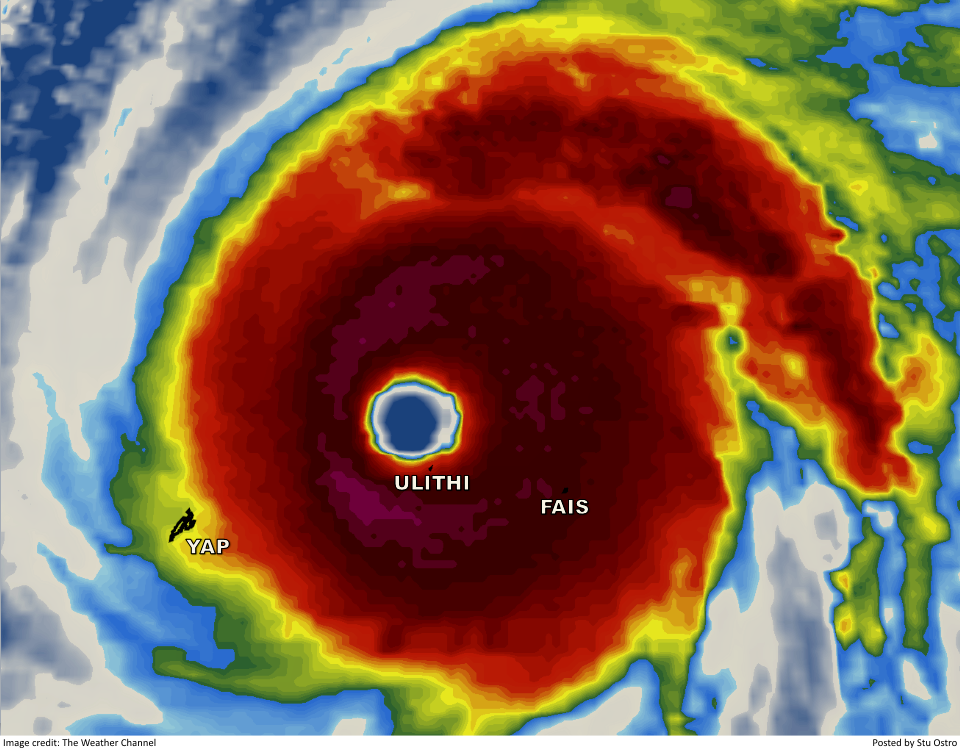Published: April 4,2015
After attaining rare March super typhoon status Tuesday, Typhoon Maysak is now feeling the influence of two weakening factors. Regardless, Maysak, called "Chedeng" in the Philippines, still poses a threat to the northern Philippines this weekend.
According to the advisory issued by the U.S. military's Joint Typhoon Warning Center in Hawaii at 5 p.m. EDT Friday, Maysak is now the equivalent of a Category 1 hurricane with maximum sustained winds of 85 mph. The center of the storm was approximately 350 miles east of Manila, the capital of the Philippines.
Increasing wind shear – changing wind speed and/or direction with height – and impinging dry air is increasingly displacing the typhoon's convection on the eastern half of the circulation.
Infrared Satellite: Maysak
The eye has now been cloud-filled for over 24 hours, a much less classic tropical cyclone on satellite compared to the super typhoon's classic eye seen earlier this week.
The combination of wind shear and dry air is expected to continue to weaken Maysak over the next day or so as it continues to track west-northwest.
However, a landfall in northern Luzon Island in the Philippines is still expected Sunday morning, local time. (Luzon is 13 hours ahead of U.S. Eastern daylight time.)
(FORECAST: Manila | Tacloban)
Given the weakening trend and a track potentially over northern Luzon, impacts in the Philippine capital of Manila should be rather minimal this weekend. However, any outer rainbands may trigger local flash flooding in the metro area, and a few strong wind gusts could lead to sporadic downed tree limbs or power outages.
Maysak's History
Early this week, Super Typhoon Maysak rapidly intensified into the equivalent of a Category 5 hurricane with maximum sustained winds of 160 mph. According to Weather Underground's Dr. Jeff Masters, Maysak is only the third super typhoon in reliable records dating to the 1940s with estimated winds that strong prior to April.Masters also said the Japan Meteorological Agency (JMA) estimated Maysak's lowest central pressure at 905 millibars on March 31, the lowest pressure they estimated for any typhoon so early in the year.
(IMAGES: Maysak Wows Space Station Astronauts)
While a super typhoon Tuesday, the Yap state island of Ulithi suffered the worst of Maysak, as the southern eyewall raked the tiny atoll with less than 1,000 residents about 420 miles southwest of Guam.
Imagine being on a remote island in darkness of night, getting hit by this. Hoping everyone there survives #Maysak
"There's no account in these people's history of a storm like this, and the damage is immeasurable," said Holland in a Facebook post Thursday. "All that is left to survive on is what can be salvaged from what didn't blow away. There's no boat to go fishing. Every big tree that had anything good on it is upside down. There's enough water to have 1 quart per day, per person. One quart a day on an island with no shade and nothing but work to do."
Maysak's eye passed just north of Yap Island on Wednesday, local time. Winds gusted up to 48 mph at Yap International Airport.
Prior to becoming a super typhoon, Maysak caused significant damage and killed at least five people in the Chuuk state of Micronesia, according to The Associated Press.
Typhoon Maysak first impacted Chuuk State, a group of Micronesian islands about 1,000 kilometers (620 miles) southeast of Guam. Winds gusted as high as 71 mph Chuuk International Airport on Weno Island in the Chuuk State of Micronesian on Sunday, local time. (Chuuk is 14 hours ahead of eastern daylight time.)
Guampdn.com reported about 95 percent of tin houses were destroyed in Chuuk state. Communications were down in the islands Saturday, but were restored Sunday. Kane Faylim, airport manager for the Chuuk state government told the Associated Press airport employees had clear rocks deposited by large waves from the runway of Chuuk's airstrip Tuesday, which has now been reopened.
(MORE: Maysak Latest News)
Unfortunately, Tropical Depression 05W will approach Chuuk State on Saturday (mainland U.S. time) and may become a low-end tropical storm by that time.
Maysak became the third typhoon of 2015, a record active early start to the year in the western Pacific, according to Weather Underground's director of meteorology, Dr. Jeff Masters.
Western Pacific Ocean tropical cyclones, called typhoons, can occur any time of the year, but typically hit a relative minimum in February and early March.
The name Maysak is Cambodian for a kind of tree.
Earlier in March, Tropical Cyclone Pam made a direct hit on the southern islands of Vanuatu in the south Pacific.
(PAM: Before/After Imagery | How You Can Help | Four Tropical Cyclones At Once)


No comments:
Post a Comment